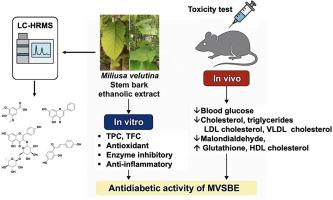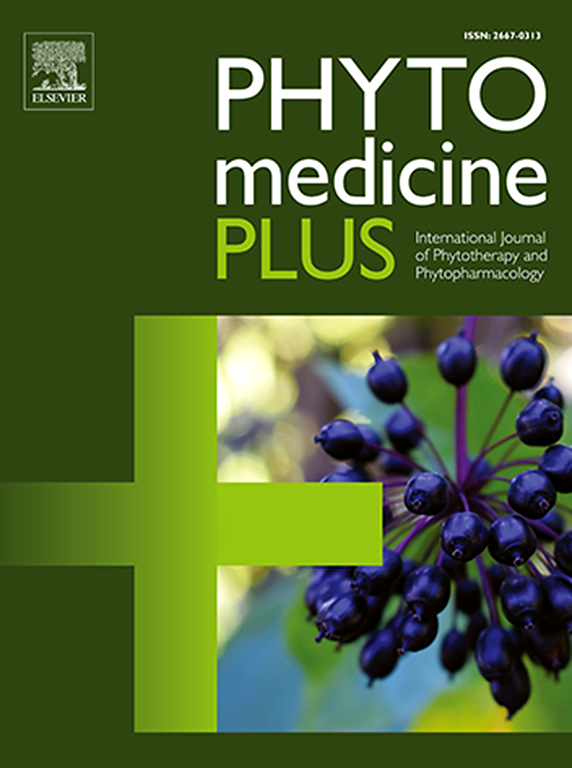Study on the toxicity and in vitro and in vivo antidiabetic activities of Miliusa velutina stem bark ethanolic extract
Q3 Pharmacology, Toxicology and Pharmaceutics
引用次数: 0
Abstract
The extracts from Miliusa velutina have been recently demonstrated to possess a range of biological activities. This study aimed to (i) identify the major bioactive compounds in M. velutina stem bark, (ii) evaluate their in vitro antioxidant, anti-inflammatory, and antidiabetic activities, and (iii) investigate the in vivo antidiabetic and toxicity profile in animal models. The M. velutina stem bark extract (MVSBE) exhibited the highest content of total polyphenols and flavonoids, significantly exceeding those found in the flower extract. Consequently, MVSBE demonstrated notable antioxidant, anti-inflammatory, and enzyme inhibitory properties, indicating its biological effectiveness. MVSBE was subsequently selected for testing its antidiabetic activity on alloxan monohydrate-induced diabetic mice. Remarkably, MVSBE effectively controlled diabetes and its complications in vivo. MVSBE strongly inhibited glucose-6-phosphatase activity, thereby reducing blood glucose levels. It significantly reduced triglycerides, cholesterol, LDL cholesterol, VLDL cholesterol, while increased HDL cholesterol. It helped to protect organs by reducing alanine transaminase (ALT) and aspartate transaminase (AST) in liver, reducing oxidative stress in liver, kidney, pancreas, heart and muscle organs based on its ability to reduce malondialdehyde (MDA) and increase glutathione (GSH). Sub-chronic administration of MVSBE at the tested dose was generally well tolerated in mice, without evidence of severe toxicity. The results from this study showed that stem bark extract of M. velutina can be a potential source for the development of antidiabetic drugs.

白耳草茎皮乙醇提取物的毒性及体内外抗糖尿病活性研究
近年来,科学家们已经证明,白毛草的提取物具有一系列的生物活性。本研究旨在(1)鉴定黄皮草茎皮的主要生物活性化合物,(2)评价其体外抗氧化、抗炎和抗糖尿病活性,以及(3)研究动物模型的体内抗糖尿病和毒性。芦笋茎皮提取物(MVSBE)的总多酚和总黄酮含量最高,显著高于芦笋花提取物。因此,MVSBE显示出显著的抗氧化、抗炎和酶抑制特性,表明其生物学有效性。随后选择MVSBE对四氧嘧啶诱导的糖尿病小鼠进行抗糖尿病活性试验。值得注意的是,MVSBE在体内有效地控制了糖尿病及其并发症。MVSBE强烈抑制葡萄糖-6-磷酸酶活性,从而降低血糖水平。它显著降低了甘油三酯、胆固醇、低密度脂蛋白胆固醇、低密度脂蛋白胆固醇,同时增加了高密度脂蛋白胆固醇。以降低丙二醛(MDA)和谷胱甘肽(GSH)为基础,降低肝脏中谷丙转氨酶(ALT)和天冬氨酸转氨酶(AST),减少肝脏、肾脏、胰腺、心脏和肌肉器官的氧化应激,起到保护脏器的作用。亚慢性给药MVSBE测试剂量在小鼠中通常耐受良好,没有严重毒性的证据。本研究结果表明,木犀草茎皮提取物可作为开发抗糖尿病药物的潜在来源。
本文章由计算机程序翻译,如有差异,请以英文原文为准。
求助全文
约1分钟内获得全文
求助全文
来源期刊

Phytomedicine Plus
Medicine-Complementary and Alternative Medicine
CiteScore
3.70
自引率
0.00%
发文量
178
审稿时长
81 days
期刊介绍:
 求助内容:
求助内容: 应助结果提醒方式:
应助结果提醒方式:


